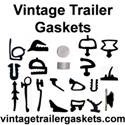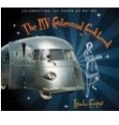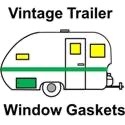Hello!
My name is Mariah and I live in a vintage trailer. What used to be a run of the mill 1969 Avalon is now the COMET – Cost-Efficient, Off-grid, Mobile Eco-Trailer, my eco-awesome tiny home and mobile classroom. I blog about my life with the COMET, tiny spaces, sustainable living, and design/build (and camper restoration) over at my website, www.cometcamper.com. I’m so excited to be contributing to one of my favorite blogs out there, LVT! Alright, on to the post.
There are many ways to make your next vintage trailer renovation, or your own camper, more eco-friendly. By re-using a vintage trailer and giving it new life through restoration, you are already practicing the most important sustainable methods: reuse, recycle, restore. Here are a few other things you can easily do to add some sustainability to your camper project!
1. Replace the Flush Toilet with a Composting Toilet
I can say with confidence that having a composting toilet in your camper is a thousand times more pleasant than dumping black water tanks. By replacing your flush toilet and black water tank system with a simple, DIY waterless composting toilet, you are saving water (less fresh water tank filling for you to deal with) and reducing waste. There are small models of composting toilets available for campers (and marine applications) but I suggest a more affordable DIY method with a simple vent out the roof (with a solar powered vent fan) like I use.
2. Compost in a Tiny Space with Vermiculture
Vermiculture is the practice of using red wiggler worms to decompose food scraps. These mighty worms work fast and silent, and my own little wiggly soldiers continue to amaze me. Vermiculture or vermi-compost is ideal for campers because it is an odorless method that doesn’t require much space at all. All you need is a small rubbermaid-type container with a lid, some worms, and your green and brown food scraps. The worms can’t digest everything, such as meat or dairy, but they make short work of pretty much everything else. The by-product is worm castings, prized for their fertile properties in the garden. I keep my worms under the front dinette bench, where their little tub fits nicely. Makes boondocking much easier when you’re not carrying out as much trash, because most of it can be composted!
3. Use Solar Power and Solar Hot Water
If you have the money to invest in a small photovoltaic system, it can be a great addition to your camper. Not only is it eco-friendly energy, it’s also great for boondocking camping trips. Want to take your trailer down to the river where there is no power? No problem. Go out into the desert for a secluded night under the stars? Go ahead, you’ll have more than enough solar power to charge you up even if you never stop at the campground. Those are some of the greatest advantages of being off the grid. Complete camping freedom.
Solar heat is even easier to utilize to heat up your water. The inexpensive camp shower (you know the black bag you fill up with a hose at the bottom?) works fantastic for washing dishes with hot water from the sun. Even if you have a hot water heater in your camper, why not use the free power of the sun instead of propane to heat up some of your water? I solely use this method in my camper, and it works great.
4. Replace with LED lighting
In the COMET, I purposefully chose to keep the original light fixtures because they are so neat. I restored them, but I didn’t want to replace them. Instead I replaced the light bulbs with LED lightbulbs of the same brightness. Though LED lightbulbs are expensive to purchase up front, they save you money over time in energy and in their long lifespan. LED lightbulbs use the same low energy as a CFL bulb, but they last 20 times as long. You may never replace a lightbulb again! LED lighting is especially important if you are planning to install a DC photovoltaic (solar power) system.
5. Use No-VOC paint for the interior
If you are painting the interior of your vintage camper, I encourage you to consider indoor air quality and use No-VOC paints. In such a small space, toxicity is especially harmful in your immediate environment. No-VOC paints are non-toxic and work just like regular paint. They do not have any odor or harmful chemicals, which makes them environmentally friendly, unlike other finishes that off-gas for months.
6. Re-Insulate for Efficiency
Are you tearing your vintage trailer down to the bones for a full restoration? If so, it’s a good idea to re-insulate your trailer for energy efficiency (heating and cooling). There are a handful of “green” insulations available today. I used ultraTouch Denim Insulation, which is non-toxic and made from blue jeans. It was super easy to fit into small spaces and tear into perfect size pieces, no hazmat suit required. Other options include natural wool insulation, which is naturally anti-bacterials and moisture wicking, and untreated fiberglass (my least favorite option). The best eco-friendly insulation is Cellulose, but that needs to be blown in and is thus not a very DIY method of insulating a trailer.
7. Use Biodegradable soaps and detergents and re-use greywater
Instead of a greywater holding tank (I didn’t want any holding tanks in my vintage trailer, except the small freshwater tank), I have a hose attached to the sink drain that drains out of the trailer underneath, into a 5 gallon bucket. I didn’t want to be dumping greywater, which if you’re conscientious can be used to water trees instead of putting it into the waste stream. You can use all 100% biodegradable soaps, dishwasher liquid, and body products so that you can put your greywater back into the ground instead of into the sewer. Biodegradable products have no toxins and are better for the environment. Some examples of biodegradable soaps that I have used include Dr. Bronner’s, Mrs. Meyer’s (mmm smells so good) and Method, as well as the “Camp Soap” you can get at any camping store! This system is simple and reduces waste.
8. Use “vintage” materials in your renovation
Lastly, I recommend using vintage replacement parts and materials when possible in your renovation. This is great because not only is re-using vintage materials more sustainable, but it also creates a very authentic look in your trailer. Using vintage fabrics, re-purposing Formica tables into retro countertops, and restoring original metal hardware are all great ways to recycle and upcycle in your trailer restoration. It can be hard to find original vintage items to re-use in your restoration, but places like Habitat for Humanity ReStore and Craigslist are great places to start, and Fletcher’s Trailer Sales is great if you’re looking for something specific such as a window or a table. Repurposing something that already exists is always better for the planet than buying something new, even if it is labeled “green” or “eco-friendly”.
Will you add any green touches or systems to your camper? Have you ever thought of going off-grid with your vintage trailer? Let us know in the comments.
















LOVE! LOVE!! LOVE!!! This article! We bought our HoneyBaked Canned Ham (65 Aristocrat) a year ago and have been working on her ever since. Vintage furnishings, Solar, LED lights, even Solar String Lights! We are in the process of building an outside shower/privy (Her name is LooLoo which will house our composting lovable! She turns heads now – can’t wait till she is “show ready”! Thanks to Kelle for all your help in guiding us on our journey!
Do you have instructions for your DIY toilet? I hate that black-water dump, too, and we’re going to more or less permanently park our li’l trailer on our li’l acreage, so I don’t want to be hauling it and out to the RV dump, anyhow!
Thanks for the blog! Can you recommend a reasonably priced solar system set up?
For a good composting toilet website google Humanure Handbook.
Thanks so much for the great tips! One of these days, when I get my own trailer, I’m definitely going to put these tidbits to use. It only makes sense to want to preserve the world we enjoy exploring, right? Thanks again for sharing.
Fantastic article. Due to retrofitting bunks for the triplets I have lost toilet space. Need to figure that out in my 72 skylark. Installed the off grid water system, one fresh water 5 gallon container pumping into sink, and grey water draining into another 5 gallon tank. Works like a charm!!
I would really like to install solar power but am a newbie…first trailer… First Reno. Any good hints out there for a rookie??
Another downside to using cellulose insulation is that it will settle over time. I learned that because my parents used it to add insulation to their first house. The settling isn’t as big an issue in a stationary house but it could be in a trailer.
Also, what do you with the finished product from the composing toilet? Do you dump it at a black water dumping station?
Did you ditch the fridge or are you producing enough electricity?